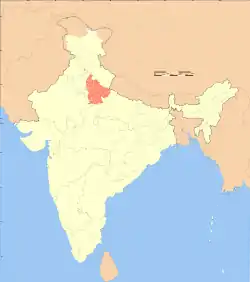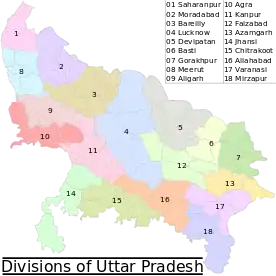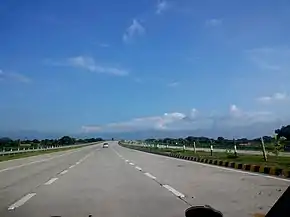Harit Pradesh | |
|---|---|
Proposed state | |
 Location of Harit Pradesh in India | |
| Country | |
| Region | Northern India |
| Proposed capital | Meerut |
| Proposed Divisions | |
| Language | Hindi, Khariboli, Haryanvi, Braj Bhasha, Punjabi |
Harit Pradesh is a proposed new state of India comprising the western parts of Uttar Pradesh state.[1] The etymology derives from harit, meaning 'green', and pradesh, meaning 'state'.
The region has some demographic, economic and cultural patterns that are distinct from other parts of Uttar Pradesh, and more closely resemble those of Haryana, Punjab and North Rajasthan areas.
Proposed Capital
The proposed capital was Meerut.It is the largest city in Harit Pradesh/Paschimanchal.It is second largest in NCR. However possibility of making a Tricity type of capital is there.It may comprise of Garhmukteshwar-Tigri-Gajraula region also which has relevance for being Middle Ganga Circuit which has huge tourism potential in it.
History
In his 1955 critique of the proposed States Reorganisation Act, Thoughts on Linguistic States, B. R. Ambedkar had advocated the division of Uttar Pradesh into three states – Western, Central and Eastern, with capitals at Meerut, Kanpur and Prayagraj, respectively – in order to prevent excessively large states from dominating politics at the national level.[2]
Later, socialists like Ram Manohar Lohia, Jayaprakash Narayan and Acharya Kripalani favoured a re-drawing of the administrative map of India. However, Jawaharlal Nehru, the prime minister at the time, supported the States Reorganisation Commission's (SRC) recommendation of re-forming states on a linguistic basis. K.M. Panikkar, in his dissenting note to the SRC report, however, opposed linguistic states and preferred the formation of a state of western Uttar Pradesh.[3]
Later, in 1972, fourteen MLAs in the Uttar Pradesh state assembly supported an unsuccessful resolution to divide the state into three units (Braj Pradesh, Awadh Pradesh and Purvi Pradesh).[4]
Advocates of New State
After the Congress working committee passed a resolution to recommend formation of a new state of Telangana on 31 July 2013, the demand for Harit Pradesh gained momentum. Jairam Ramesh suggested that Uttar Pradesh's reorganisation was necessary as it is difficult to run such a big state effectively. He said that "[...] from an administrative point of view, a state of over 200 million people, 75 districts, over 800 blocks ... It's just not governable. It is my personal view...Its politics is a separate issue."[5]
Capital
Meerut has been constantly proposed as the capital of the state by B.R Ambedkar, Mayawati, and Union Minister Sanjeev Balyan.[6]
While western Uttar Pradesh accounts for 51.71% of the state's GDP, Bundelkhand accounts for just 5.22%, though it has risen from 4.95%. Western Uttar Pradesh has been generating the most revenue for the government and not given enough representation in the UP government, receiving only 18% of the state's budget to be spent on developing western Uttar Pradesh while contributing more than 51.71% to the state.[7]
Residents of western Uttar Pradesh have also been demanding a high court bench from the Allahabad High Court. Almost 54% of all cases reaching the high court originate from the 22 districts of western Uttar Pradesh, though the area does not have its own high court.[8]
Geography
Soil conditions
Western Uttar Pradesh's soil and relief has marked differences from that of the eastern part of the state.[9] The soil tends to be lighter-textured loam with some occurrences of sandy soil.[10] Some loess soil is continuously deposited by winds blowing eastwards from Rajasthan's Thar Desert.[11]
Precipitation
Harit Pradesh receives rain through the monsoon and western disturbances. The monsoon carries moisture northwards from the Indian Ocean, occurs in late summer and is important to the Kharif or autumn harvest.[12][13] Western disturbances carry moisture eastwards from the Mediterranean Sea, the Caspian Sea, and the Atlantic Ocean.[14][15][16][17] They primarily occur during the winter season and are important for the main staple of the region, wheat, which is classified as a rabi crop.[15]
Administrative divisions

Western Uttar Pradesh includes 17 districts in six divisions:
- Saharanpur division: Saharanpur, Muzaffarnagar, Shamli districts
- Moradabad division: Moradabad, Bijnor, Amroha, Sambhal districts
- Meerut division: Meerut (Proposed Capital), Bulandshahr, Gautam Buddha Nagar, Ghaziabad, Hapur, Baghpat districts
- Aligarh division: Aligarh and Hathras Kasganj Etah District districts
- Agra division: Agra and MathuraFirozabad Mainpuri
Education
| School | Location | Established | Comment | Ref. |
|---|---|---|---|---|
| Aligarh Muslim University | Aligarh | 1920 | Aligarh Muslim University is a public university funded by the Government of India. It was originally established by Sir Syed Ahmad Khan as Mohammedan Anglo-Oriental College in 1877. | [18] |
| Chaudhary Charan Singh University | Meerut | 1965 | The university is named after Chaudhary Charan Singh, the fifth Prime Minister of India. | [19] |
| Dr B. R. Ambedkar University | Agra | 1927 | This university was formed as Agra University and renamed in 1996. | [20] |
| Gautam Buddha University | Greater Noida | 2002 | [21] | |
| M. J. P. Rohilkhand University | Bareilly | 1975 | M.J.P. Rohilkhand University was established in 1975 as an affiliating University. The senior faculty members of different disciplines in Humanities, Science and Technology are running research projects funded by various agencies and so far 49 projects funded by UGC, AICTE, DST, CST, ICAR, ICHR, MIF have been completed. | [22] |
| Sardar Vallabhbhai Patel University of Agriculture and Technology | Meerut | 2004 | [23] | |
| Glocal University | Saharanpur | 2012 | Glocal University is a private and coeducational institution located in Saharanpur, Uttar Pradesh, India. It is situated in the foothills of Shivalik mountains. | [24] |
| Invertis University | Bareilly | 2010 | [25] |
Special economic zones
Transport networks

Major state and national highways passing through the proposed area include:
- DND Flyway
- Noida Greater Noida Expressway
- Delhi Meerut Expressway
- Delhi Meerut RRTS
- Ganga Expressway
- Yamuna Expressway
- NH-58
- NH-24
- NH-2
The major highways running through the intrastate region include:
 Toll Plaza at Mathura
Toll Plaza at Mathura NH-58 in Meerut
NH-58 in Meerut.jpg.webp) DND flyway in Noida
DND flyway in Noida Yamuna Expressway is India's longest six-lane controlled-access expressway stretch
Yamuna Expressway is India's longest six-lane controlled-access expressway stretch
Demographics
According to the 2011 census of India, the total population within the proposed state was 71,740,055.out of 24.21℅ is muslim About 17,368,267
The population of Western Uttar Pradesh is composed of a varied set of communities and tribes, including[27]
- Brahmin / Tyagi s: 17%
- Jats: 10%
- Rajputs: 8%
- Yadav/Ahir: 6%
- Gujjars: 9%
- Lodhi: 5%
- Saini: 5%
- Dalits: 17%
- Kayastha: 1.2%
- Kurmis: 2%
- Kashyap/ Baghel: 4%
- Baniya: 2%
- Rohilla: 6%
- Muslim Rajput: 6%
- Ranghar/Jojha: 5%
- Rayeen: 4%
- Jat Muslim: 3%
- Garha / Tyagi Muslims: 3%
- Jat Sikh: 0.4%
| Most populous cities in Harit Pradesh | ||||||||||
|---|---|---|---|---|---|---|---|---|---|---|
| City | District | Population | City | District | Population | |||||
| 1 | Ghaziabad | Ghaziabad | 2,381,452 | 7 | Saharanpur | Saharanpur | 705,478 | |||
| 2 | Agra | Agra | 4,418,797 | 8 | Noida | Gautam Budh Nagar | 637,272 | |||
| 3 | Meerut | Meerut | 3,309,023 | 9 | Muzaffarnagar | Muzaffarnagar | 495,543 | |||
| 4 | Bareilly | Bareilly | 898,167 | 10 | Mathura | Mathura | 601,894 | |||
| 5 | Moradabad | Moradabad | 889,810 | 11 | Budaun | Budaun | 369,221 | |||
| 6 | Aligarh | Aligarh | 874,408 | 12 | Rampur | Rampur | 325,248 | |||
| Source: Census of India 2011[28] | ||||||||||
The region's Rohillas are descended from immigrant groups from centuries ago, and a large subregion of western Uttar Pradesh, Rohilkhand, takes its name from that Pashtun tribe.[29]
Sikhs from West Punjab, who migrated from Pakistan after partition, also settled in this area in large numbers.[30]
Role of specific rural communities
Jats, who are a dominant agricultural community spread across Pakistan, Punjab, Haryana, Rajasthan and Uttar Pradesh, have found themselves in a "politically disadvantageous position" in western Uttar Pradesh.[31]
The most prominent current-day advocate for the creation of the new state is Ajit Singh, the leader of the Rashtriya Lok Dal party. Pushpendra Singh, former General Secretary of Youth wing of Rashtriya Lok Dal, also launched a political party called Harit Pradesh Party to create a separate state of Western Uttar Pradesh. Other Jat leaders, such as Om Prakash Chautala in Haryana, the leader of the Indian National Lok Dal, have also made efforts to involve themselves in the politics of creating a separate state.[32] Since the Muslim population in western Uttar Pradesh (34%, according to various sources) is higher than in Uttar Pradesh as a whole (17%), the proposal has found support from Muslim-affiliated organizations.[33][34][35][36] Of the other main political forces in Uttar Pradesh, the Bahujan Samaj Party has supported the demand in principle, the Samajwadi Party has opposed it, and the Indian National Congress and the Bharatiya Janata Party have adopted a non-committal stance.[37]
Rashtriya Lok Dal alleges that "Western UP contributes to a large chunk – nearly 72% – of the state's total income. In turn, what western UP gets is not enough. Just 18% of the state's budget is spent on developing west UP. This anomaly, understandably, makes the people of this area dissatisfied". There are allegations that in most years, funds allocated to west Uttar Pradesh were never spent. According to Dal, only 18% of the state's budget is spent on developing west Uttar Pradesh.[38]
The creation of three new states in 2000 (Jharkhand from the division of Bihar, Uttarakhand from the division of Uttar Pradesh and Chhattisgarh from the division of Madhya Pradesh) gave new impetus to the demand for Harit Pradesh.[31]
After coming to power in the Bahujan Samaj Party government, Mayawati wrote letters to the prime minister regarding the partitioning of Uttar Pradesh into four different states in 2007, March 2008, and December 2009.[39][40] On 15 November 2011, Mayawati's cabinet approved partitioning Uttar Pradesh into four different states—Harit Pradesh, Awadh Pradesh, Bundelkhand and Purvanchal—for better administration and governance.[41]
See also
References
- ↑ Sajal Basu (2005), Regionalism, ethnicity, and left politics, Rawat Publications, ISBN 81-7033-930-8,
... perhaps only to strengthen his own demand of a separate Harit Pradesh comprising 17 districts from western UP ...A consequent demand for the separation of the more prosperous western districts of UP which have been the bastion of the green revolution, and have variously been named as Pashchim Pradesh or more recently as Harit Pradesh by Ajit Singh ...
- ↑ Bhimrao Ramji Ambedkar (1955), Thoughts on Linguistic States,
... The only remedy is to break up the Northern States of U.P., Bihar and Madhya Pradesh. How did this solution not strike the Congress Working Committee I am unable to understand ... My proposal with regard to the Uttar Pradesh is to divide it into three States. The three States of the Uttar Pradesh could have as their capitals (1) Meerut (2) Kanpur and (3) Allahabad ...
- ↑ "Now demand to divide Uttar Pradesh picks momentum".
- ↑ Boris Ivanovich Kluyev (1981), India: National and Language Problem, Sterling,
... For example, in May 1972 fourteen members of the Uttar Pradesh Assembly submitted a resolution for setting up three new States - Braj Pradesh, Awadh Pradesh and Purvi Pradesh. The resolution was defeated. Curiously enough, the arguments of those supporting division were essentially the same, although the representatives hailed from different regions of Uttar Pradesh ...
- ↑ "Jairam Ramesh Favours Reorganisation of UP". Outlook. PTI. 31 July 2013. Archived from the original on 31 August 2013. Retrieved 17 July 2022.
- ↑ "पश्चिमी यूपी को बनाया जाए अलग राज्य, मेरठ बने राजधानी, केंद्रीय मंत्री संजीव बालियान ने की मांग". Hindustan (in Hindi). Retrieved 2 October 2023.
- ↑ "Noida tops Uttar Pradesh GDP & per capita income again, Lucknow is second". The Times of India. 13 March 2020. ISSN 0971-8257. Retrieved 2 October 2023.
- ↑ "Allahabad HC bench in west UP: Govt says no complete proposal pending". The Economic Times. 7 April 2022. ISSN 0013-0389. Retrieved 2 October 2023.
- ↑ Aijazuddin Ahmad (2009), Geography of the South Asian subcontinent: a critical approach, Concept Publishing Company, 2009, ISBN 9788180695681,
... These differences are caused by the depositional work of rivers, local climates, natural vegetation cover and the soil. Even the difference between the plains of western Uttar Pradesh and eastern Uttar Pradesh is quite well marked ...
- ↑ A.K. Kolay (July 2007), Soil Genesis, Classification Survey And Evaluation, Volume 2, Atlantic Publishers & Distributors, 2007, ISBN 9788126908035,
... ...
- ↑ M. Hanif (2005), Encyclopaedia of Agricultural Geography, Anmol Publications Private Limited, 2005, ISBN 9788126124824,
... Loess is the finest particle of sand carried by winds from desert (Thar desert) to the neighbouring areas of Haryana, Punjab, Western Uttar Pradesh and western Madhya Pradesh. Here a thin layer of loess particles ...
- ↑ Vidya Sagar Katiyar, "Indian Monsoon and Its Frontiers", Inter-India Publications, 1990, ISBN 81-210-0245-1.
- ↑ Ajit Prasad Jain and Shiba Prasad Chatterjee, "Report of the Irrigation Commission, 1972", Ministry of Irrigation and Power, Government of India, 1972.
- ↑ "Western disturbances herald winter in Northern India". The Hindu Business Line. 17 November 2005. Archived from the original on 14 February 2009. Retrieved 20 October 2008.
- 1 2 Bin Wang, "The Asian Monsoon", Springer, 2006, ISBN 3-540-40610-7.
- ↑ R.K. Datta (Meteorological Office, Dum Dum) and M.G. Gupta (Meteorological Office, Delhi), "Synoptic study of the formation and movements of Western Depressions", Indian Journal of Meteorology & Geophysics, India Meteorological Department, 1968.
- ↑ A.P. Dimri, "Models to improve winter minimum surface temperature forecasts, Delhi, India", Meteorological Applications, 11, pp 129–139, Royal Meteorological Society, Cambridge University Press, 2004.
- ↑ "Aligarh Muslim University || History". www.amu.ac.in. Retrieved 25 September 2016.
- ↑ "Chaudhary Charan Singh University, Meerut | About Us". ccsuniversity.ac.in. Archived from the original on 21 July 2011. Retrieved 29 July 2011.
- ↑ "Dr B. R. Ambedkar University". dbrau.ac.in. Archived from the original on 21 July 2011. Retrieved 29 July 2011.
- ↑ "About Us". gbu.ac.in. Archived from the original on 21 July 2011. Retrieved 29 July 2011.
- ↑ "M.J.P. Rohilkhand University". mjpru.ac.in. Archived from the original on 31 July 2011. Retrieved 29 July 2011.
- ↑ "Sardar Vallabha Bhai Patel University". svbpmeerut.ac.in. Retrieved 29 July 2011.
- ↑ University, Glocal. "Why Glocal | Glocal University". www.glocaluniversity.edu.in. Retrieved 25 September 2016.
- ↑ "Invertis University". UniRank. Retrieved 1 March 2017.
- ↑ "Uttar Pradesh Religion Data - Census 2011". Archived from the original on 4 March 2016. Retrieved 26 February 2016.
- ↑ T. V. Sathyamurthy (1995), Industry and agriculture in India since independence: Social change and political discourse in India Volume 2, Oxford University Press, 1995, ISBN 9780195634570,
... the Jats, Ahirs, Gurjars and Kurmis. These castes comprise nearly 40 per cent of the population in Meerut, Muzaffarnagar, Saharanpur, and Bijnor districts. Rajputs and Tyagi, also cultivate their own land.
- ↑ (2011 Census of India estimate)"India: Harit Pradesh". City Population. Thomas Brinkhoff. 25 January 2014. Retrieved 23 February 2015 – via Population Census India.
- ↑ Ghaus Ansari (1960), Muslim caste in Uttar Pradesh: a study of culture contact (Volumes 12–13 of The Eastern Anthropologist), Ethnographic and Folk Culture Society, 1960,
... confined primarily to the Rohilkhand and Meerut divisions of Uttar Pradesh. Pathans are generally considered to have come either from Afghanistan or from the Pashto-speaking tribes of the North-West ...
- ↑ Bagaulia (2005), Encyclopaedia Of Human Geography (Set Of 3 Vols.), Anmol Publications PVT. LTD., 2005, ISBN 9788126124442,
... Sikhs also settled down in the Terai region of Uttar Pradesh, transforming this once malaria-infested wetland into a granary of northern India ...
- 1 2 Jagpal Singh (4 August 2001), "Politics of Harit Pradesh: The Case of Western UP as a Separate State", Economic and Political Weekly, 36 (31): 2961–2967, JSTOR 4410945,
... It is spearheaded by the politicians, especially a section of Jats, belonging to western UP. Ajit Singh has been playing a pivotal role in it ...
- ↑ "INLD bid to get foothold in UP", The Tribune, 5 July 2001, retrieved 24 July 2009,
... the move of the Indian National Lok Dal (INLD) supremo and Chief Minister of Haryana, Mr Om Prakash Chautala, to raise the demand of a separate 'kisan pradesh' out of western UP ... Since Mr Ajit Singh has also raised the demand of creating a 'harit pradesh' in the same region, the move by both Mr Chautala and Mr Ajit Singh is seen as only a political strategy to 'outwit' each other ...
- ↑ "Minister's demand for Muslim Pradesh condemned", The Times of India, 19 July 2006, archived from the original on 24 October 2012, retrieved 24 July 2009,
... demand is neither feasible nor proper,"said Manzoor Ahmad, former vice-chancellor of Dr B R Ambedkar University, Agra ... Muslim population which is not more than 25% in Western UP. ...
- ↑ "Ajit Singh struggling to retain Muslim vote", The Hindu, 12 February 2002, archived from the original on 5 November 2004, retrieved 24 July 2009,
... the Muslim presence in western U.P. is said to be about 34 per cent ...
{{citation}}: CS1 maint: unfit URL (link) - ↑ Khan, M.E., Patel, Bella, C., "Reproductive Behaviour of Muslims in Uttar Pradesh", The Journal of Family Welfare, March 1997. 43(1) p. 13-29. Available online at
- ↑ "Imams back campaign for 'Harit Pradesh'", The Hindu, 18 August 2001, archived from the original on 5 November 2012, retrieved 24 July 2009,
... campaign for `Harit Pradesh' ... appears to be gathering momentum with the All-India Imam Association, an influential body of Muslim clerics, today pledging support ...
- ↑ "Mayawati joins issue with Paswan, Ajit Singh", The Hindu, 26 June 2001, archived from the original on 6 June 2011, retrieved 24 July 2009,
... She said the BSP stood for creation of Harit Pradesh ...
{{citation}}: CS1 maint: unfit URL (link) - ↑ "Ajit Singh reiterates Harit Pradesh demand", The Times of India, 10 January 2011,
...In turn, what western UP gets is not enough ...
- ↑ "UP division Mayawati asks Congress, BJP to clarify stand".
- ↑ "Chief Minister Mayawati said the Centre's inaction over a 2007 letter forced her government to take the matter to the House".
- ↑ "Mayawati wants UP divided into four new states". zeenews.india.com. Zee News Ltd. 15 November 2011. Retrieved 2 July 2013.
External links
- Hindu on Net[usurped]
- Tribune India
- South Asia Anal
